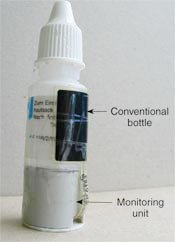Eyedropper monitor measures degree of patient compliance
A study using the device revealed poor compliance in terms of total dose, time intervals and premature discontinuation.
Click Here to Manage Email Alerts
An electronic device that monitors patient compliance with topical medication regimes allows physicians to keep patients on a short leash when proper dosage is critical, according to the device’s developers.
Michael Diestelhorst, MD, and Manuel Hermann, MD, of the University of Cologne, working in conjunction with Can Üstündag, MD, of the Dünyagöz Eye Clinic in Istanbul, developed a microprocessor-controlled bottle monitor that can measure and store information about time, date, and medication dosage and temperature, as well as the position of and pressure on the bottle.
|
|
Information from the bottle can be analyzed weeks or months after the device has been used, providing doctors with valuable information about patient habits and the management of their condition.
Drs. Diestelhorst, Hermann and Üstündag conducted a study with the device to track the real-world compliance of ambulant cataract patients after surgery. Number of applications, timing, total dose and coverage of medication were monitored in the study.
“Noncompliance can result in visual loss,” the researchers said. “Especially cataract patients are often naïve to topical treatment.”
Poor compliance
The study, presented as a scientific poster at the Association for Research and Vision in Ophthalmology meeting, included 20 eyes of 20 cataract patients whose mean age was 62.9 years.
After performing phacoemulsification and IOL implantation, the doctors told the patients to apply a fixed-combination drop of prednisolone 1% and gentamycin five times daily between 8 a.m. and 10 p.m. for 14 days. The dosage, when done properly, would total 70 applications.
Additionally, nine patients were randomly assigned to keep the bottle refrigerated.
The results retrieved from the monitoring device showed that the mean total of administered drops was 33.3 drops per patient during the 14-day period. Individual patient dosage ranged from as low as seven drops during the dosage period to 71 drops (See table below).
The monitors on the bottles showed that 10 patients applied less than 50% of the total dosage, and four patients applied less than 25% of the prescribed medication. Compliance did not improve even during the 24-hour period preceding the return appointment.
While mean applications per day were at their highest on the first day of treatment, compliance still did not reach the full five drops in that day.
“All patients were noncompliant with regard to total dose, time intervals and premature discontinuation of therapy,” the researchers said.
The recorded bottle temperatures of the group assigned to keep the bottles refrigerated were significantly lower compared to the other participants, but there was no significant difference between the warm and cold groups in terms of the number of applications, the researchers found.
According to Dr. Diestelhorst, the cold and warm groups were created not only to see what effect the temperature might have on the drug, but also to see how well the patients followed instructions other than the dosage.
“We concluded that the patients were willing to be compliant with that since it is an easy task to bring [the drops] back to the refrigerator,” Dr. Diestelhorst told Ocular Surgery News. “However, it is much more difficult to use it five times daily and at proper time intervals.”
According to the study results, the device was not able to monitor “dys-compliance,” which Dr. Diestelhorst defined as missed or inaccurate doses due to patient difficulties, such as shaky hands, premature blinking or inability to approach the eye with the device.
 |
Future implications
According to the researchers, this was the first study of its kind in ambulant cataract patients, and it is a step toward improved understanding of real-world treatment in ophthalmology.
The device and the study findings will open the way not only for improving patient outcomes and maximizing the efficiency of topical therapy, but it also could possibly improve the outcome and importance of clinical trials for new drugs.
“The U.S. FDA will like this because we will have more precise clinical data from the microchip to be reanalyzed,” Dr. Diestelhorst said.
“This is the beginning of understanding the risks of individual treatment failure,” Dr. Diestelhorst told Ocular Surgery News. “Further studies in glaucoma will begin this year.”
For Your Information:Reference:
- Michael Diestelhorst, MD, can be reached at Universitäts-Augenklinik Köln, Joseph-Stelzmann-Str. 9, 50931 Köln, Germany; +49-221-478-4609; e-mail: michael.diestelhorst@uk-koeln.de.
- Herman MM, Üstündag C, Diestelhorst M. Compliance with topical therapy after ambulant cataract surgery using a new microprocessor-controlled eye drop monitor. Poster presented at the Annual Meeting of the Association for Research and Vision in Ophthalmology; May 4, 2005; Ft. Lauderdale, Fla.
- Jared Schultz is an OSN Staff Writer who covers all aspects of ophthalmology. He focuses geographically on Europe and the Asia-Pacific region.

